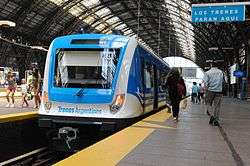Tren al Desarrollo
 | |
|
La Banda station, terminus of the line. | |
| Overview | |
|---|---|
| Service type | Commuter rail |
| Status | Active |
| Locale | Santiago del Estero |
| Predecessor | Ferrocarriles Argentinos |
| First service | September 19, 2016 |
| Route | |
| Start | Santiago del Estero |
| Stops | La Banda |
| Distance travelled | 8 km (5.0 mi) |
| Average journey time | 25 min |
| Service frequency | 30 min [1] |
| Line used | Mitre Railway |
| On-board services | |
| Class(es) | Unique |
| Technical | |
| Track gauge | 1,676 mm (5 ft 6 in) |
| Track owner(s) | Government of Argentina |
Tren al Desarrollo (in English: "Train to Development") is an elevated commuter rail service between the cities of Santiago del Estero (from the "Forum" station) and La Banda (with also a new building) in Santiago del Estero Province. Trains run on 1,676 mm (5 ft 6 in) Mitre Railway tracks were disused. The line also crosses the Puente Negro, a bridge that had been closed for over 40 years.[2]
At the beginning, the project only planned a 4 km-long line, then extended to 8 km. length to reach La Banda.[3][4]
Rolling stock used are railbuses made by Argentine company TecnoTren.[5] Each unit has a capacity of 100 passengers (70 seated). The journey time will be about 25 minutes.[6] Santiago Centro terminus station was inaugurated in May 2015.[7]
A total of 3 new stations were projected to built, "Botánico" (with access to the botanical garden), "Parque Tecnológico" (in the industrial park of the city) and "Banda", terminus of the line.[8] The total path from Forum to Banda stations will be a 5,10 metre-high viaduct to avoid interfering with road traffic.[9][10]
A third phase of the project focuses on reaching the Termas de Río Hondo, one of the main attractions of the Province,[11] although it could be extended to San Miguel de Tucumán.[12]
In September 2016, the first section of 4-km length (from Santiago to Nodo Tecnológico) was inaugurated. The next section to La Banda is expected to be opened in March 2017.[13]
See also
References
- ↑ "Mirá los horarios en los que puedes viajar en el Tren al Desarrollo a Tecnópolis", Nuevo Diario, 20 Sep 2016
- ↑ "Tren al Desarrollo, obra pronto a ser inaugurada", SDE Government
- ↑ "Randazzo visitó la futura estación del "Tren al Desarrollo" en Santiago del Estero", Telam, 17 Jun 2014
- ↑ "Randazzo visitó la futura estación del "Tren al Desarrollo", en Santiago del Estero", La Gaceta, 18 Jun 2014
- ↑ "Santiago del Estero: La estación Fórum del Tren del Desarrollo impacta por su diseño" on Crónica Ferroviaria, 11 May 2015
- ↑ "Iniciarán pruebas del Tren al Desarrollo en la estación Fórum", El Liberal, 12 May 2015
- ↑ "La gobernadora y Randazzo inauguraron el Tren al Desarrollo", Government of Santiago del Estero, 14 May 2015
- ↑ "Difunden cómo será el Tren al Desarrollo que tendrá Santiago del Estero", Noroeste Santafesino website
- ↑ "Visita oficial al Tren del Desarrollo", Rieles.com, 13 May 2015
- ↑ "En un año estaría concluido y listo para inaugurar Tren al Desarrollo", Nuevo Diario web, 13 May 2015
- ↑ "El tren al desarrollo unirá Santiago, Banda y Las Termas", El Liberal, 18 Jun 2014
- ↑ "El Tren al Desarrollo unirá Santiago del Estero y Tucumán", Cadena3, 20 Jun 2014
- ↑ "Claudia de Zamora inauguró el primer tramo del Tren al Desarrollo", El Liberal, 19 Sep 2016

